Project Nahual
The blog
In this blog I will explain my journey on this project and maybe share some other thoughts if they ever come to my mind.
The project
The project is in its first steps and best described by the blog article “On Project Nahual”. Have a look and maybe let you inspire yourself.
Me, myself and I
Who is “I”? I’m Jannik Baumgart. I am from germany, currently working at a medtech company and am a space nerd by heart.
-
On how the work actually looks
I want to share some progress on my work with the Space Weather Modeling Framework. To get you on board again, I try to simulate a solar magnetic shield for Mars. It is best explained in the blog article On Project Nahual. Somewhere later in time, I got prominent support and discovered the Space Weather Modeling Framework (SWMF). For that, see On plans.
In the meantime, I got a lot more comfortable with the usage of the SWMF. I use the software to simulate planetary magnetic fields (like Earths magnetic field) and their interaction with solar wind. This way, I get a better understanding about how these magnetic fields behave and what influences them. But to get away from this most theoretical level (and stay on a still very theoretical level), I first want to share, how this work actually looks.
The SWMF is capable of many things and it has a specific module called “global magnetosphere”, which is exactly what I need and use. After an installation in a Linux distribution inside Windows, I can start a modelling run by providing a parameter file and giving a start command. This is now quite comfortable. However, it took me quite a while to get the inputs to the parameter file reliably working. I added a video to show the workflow.
My SWMF workflow – Linux subsystem for windows is on the left and controls the SWMF, on the right is the parameter file. After a completed run, a post-processing script produces readable data, from which I produce images with a python script of most questionable quality. With this setup in place, I can always directly see the outcome of changes in the parameter file. My currently latest advancement is the modeling of two separate magnetic fields, the Earths and an arbitrary second object. In later stages, this would be the Mars without a magnetic field and a small object with magnetic field of not yet known specifications.
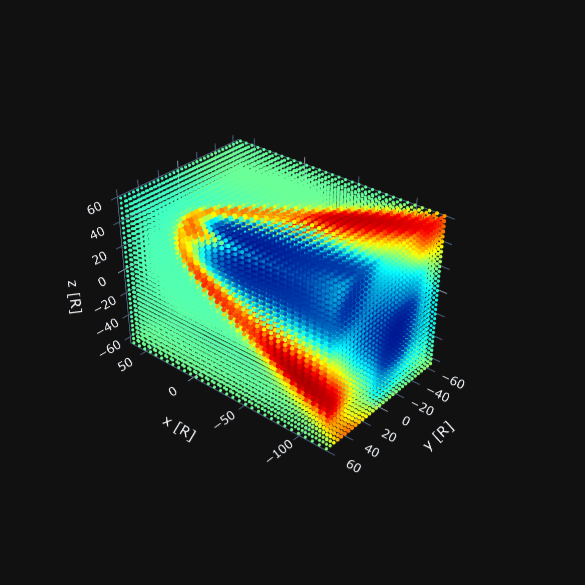
This was my first successful image for two separate magnetic fields. The color of the dots represents the density, the size represents pressure. With this representation, you can perfectly see the red high-density bow shock line and its low density region forming behind. With this “#SECONDBODY”-feature learned, I started to look at some simulations closer to my use case. While I could just change to Mars as a chosen first object, it would not interact with the solar wind on a planetary scale, so it does not give me additional information (and looks less interesting). The second interesting change for my use case is the actual distance of things. The “global magnetosphere” model uses the planet radius as distance unit. I understood this only pretty recently as I tried to get the distance of things right. While it may seem counterintuitive to have a distance measurement and a grid which is completely different for each planet, it saves computational resources to normalize everything to this. At least that is how I understood the design choice explanation.
This also means, a grid, which is from -60 to 60 [R], actually spreads over 120 Earth radii with only 20-something dots (depends on the refinement parameters). So there easily fits an Earth or two between each of the simulation dots. The Earth has a mean radius of 6.137 km. It is possible to get better resolution, but of course, this costs computing power and I need to learn, how the refinement parameters work. To achieve the distance of Mars and its L1 Lagrange point, I would need to place the second object at around 140 Earth radii. I tried this, but I got several problems, with the size and uniformity of the grid as well as even this level of refinement. This is nothing, which cannot be solved by some tinkering with the parameters, however to get something working for this milestone, I settled for 80 Earth radii distance, because I got it to work way easier. For Earth, this is a distance of around 500000 km. For reference, the moon is at 384400 km and the ISS is at around 420 km. Actually calculating the distances always gives me a feeling for the actual size of even our closest neighborhood.
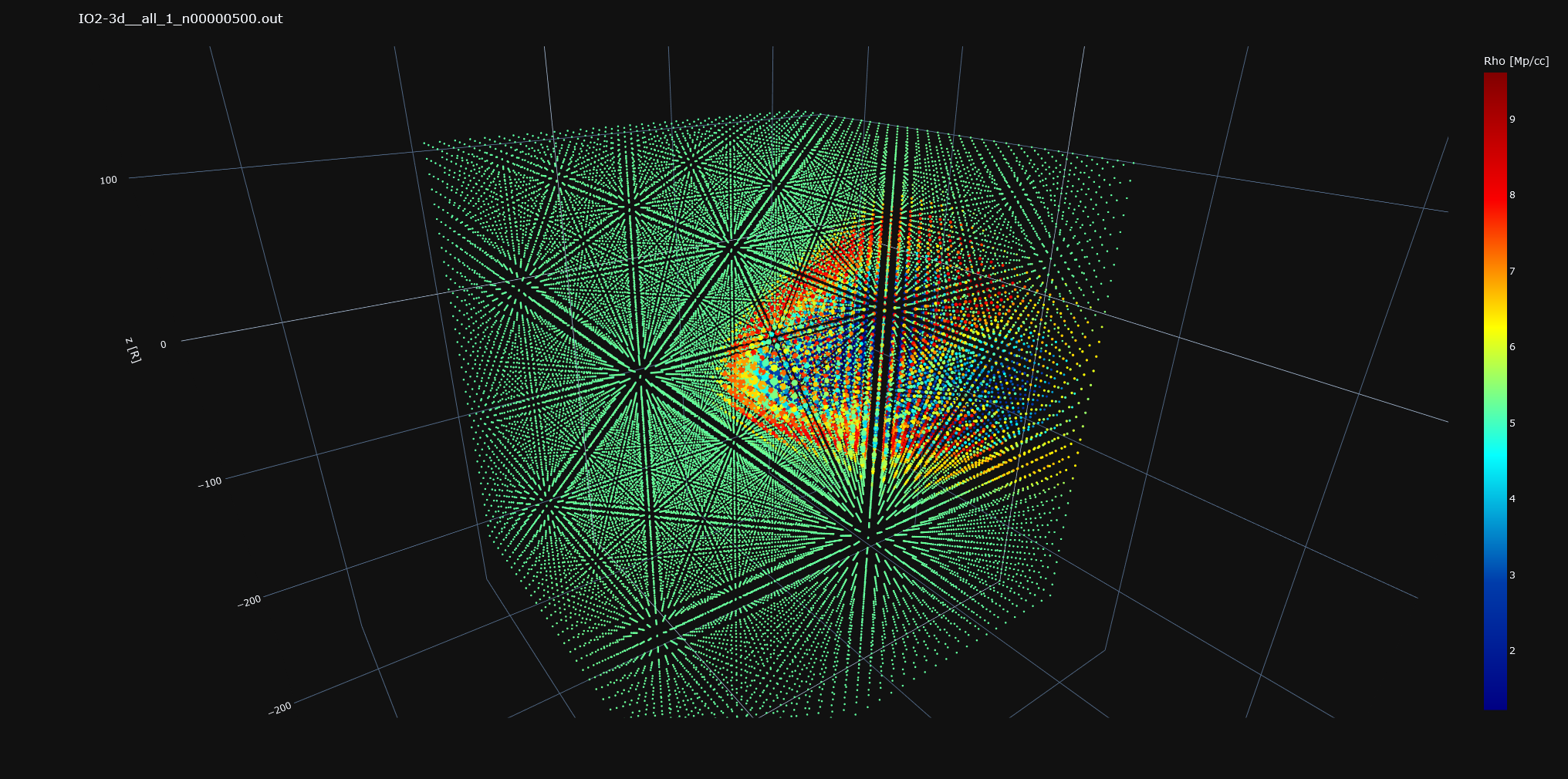
Image of the simulation with 80 Earth radii distance between two bodies on the Y-axis. Another target or idea for this milestone was to improve the images by reducing less useful data. It obstructs the view and the python imaging library Plotly also has some soft limitations on how many dots it can produce. When working with the WSA-ENLIL model, the size of the less interesting dots conveniently was small enough, however for the SWMF and my parameters, this is not the case. Additionally, the most interesting dots are the ones with very high or very low values. As a cheap solution, I just not printed dots with the median density +- 5%.
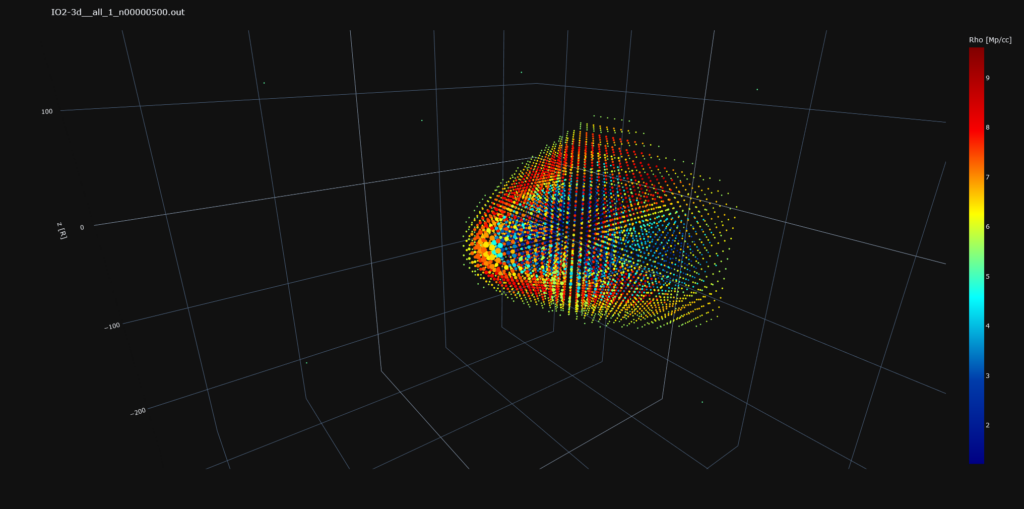
Image of the 80 Earth radii simulation with only data points printed, which are not the median +-5% density. Will be referred to as “relevant grid”. 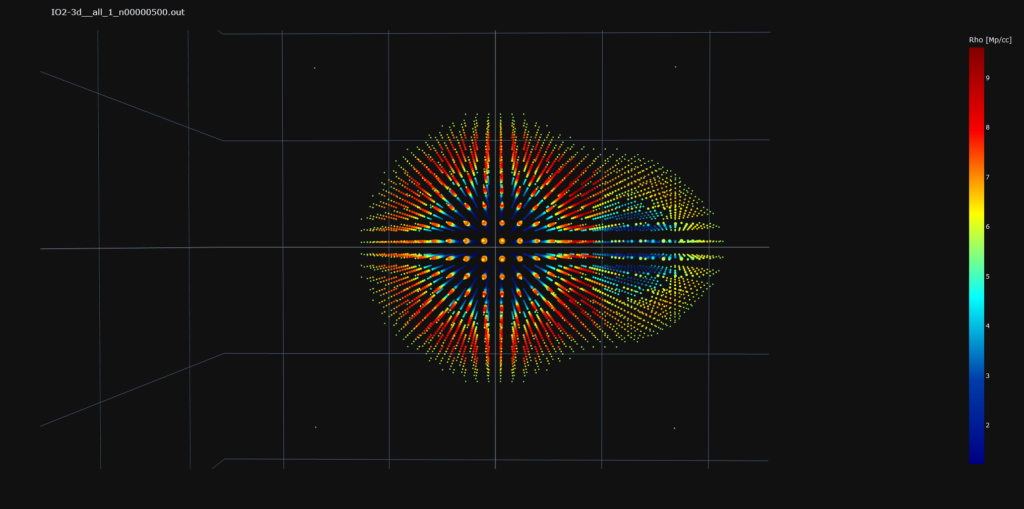
Image of the 80 Earth radii simulation with relevant grid from the front. While a 2D representation might be more useful or clearer for a website, I am very happy for the 3D images, as they allow for a better understanding of the data and a more direct way to spot errors, as explained in my first blog post On graphing the stars.
Now for a last learning with this feature, I wanted to move the second body between Sun and Earth. See the following top-view images.

Image of the 80 Earth radii simulation with relevant grid from the top. 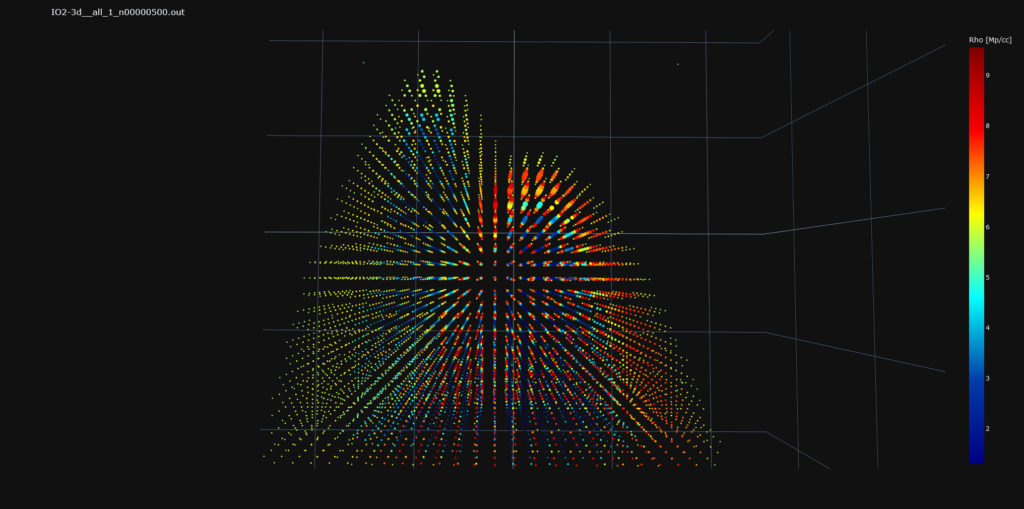
Second body moved on X-Y-plane with 80 Earth radii distance with relevant grid from the top. 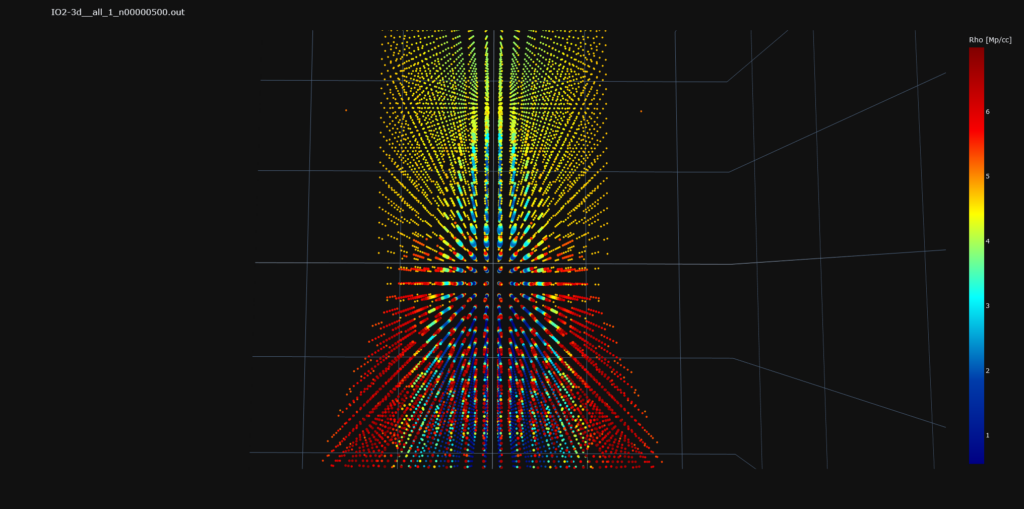
Second body with 80 Earth radii distance on X-axis with relevant grid from the top. With moving the second body from the Y axis to the X Axis in Front of the Earth, I get this simulation artifact, where no bow shock can be found for the second body in front of the Earth. I suspect, the “perturbation” of the magnetic field are too close to the connection to the ambient medium, which feeds the “global magnetosphere” model. I experienced a similar issue, when I moved the X-axis simulation border too close to the Earth at an earlier testing. I suspect to solve or work around this problem and increase my simulation size and resolution, but for the moment I am quite happy, to get a reliable output and gaining a lot of knowledge about the SWMF as well as space weather itself.
I currently plan to do a bit of paper reading to feed my learnings of space weather with technical Know-how. But plans change as the weather does. And in the meantime, life happens to be complicated. Beautiful and complicated. See you around.
All pictures and content to download: On-how-the-work-actually-looks.zip
Direct link to post and comments: https://nahual.eu/on-how-the-work-actually-looks/
-
On plans
So, sometimes life goes not exactly like you plan it to be. On closer look, it rarely goes as expected. Depending on how you feel about live and curiosity, this is usually a good thing. In the last blog post, I told you about the plans I had with the WSA-ENLIL model. Spoiler alert: plans changed.
In the first steps of Project Nahual, I familiarized myself with solar wind with the help of the WSA-ENLIL model. To start an actual simulation of an artificial Martian magnetic shield, I tried to get my hands on the source code of this WSA-ENLIL model. I dug through the internet without success. The only option would be to request a run with specific parameters, though defining such specific parameters (e.g. ones who actually weren’t intended by the creator) is impossible without an extensive documentation or the source code. I found this option at the Community coordinated modeling center (CCMC) run by NASA. https://ccmc.gsfc.nasa.gov/
In an old school attempt, I wrote an email describing my issue to the CCMC model hosts. And someone answered! Someone from NASA wrote me an email. This absolutely made my week and is still absolutely awesome. Unfortunately, they could not help me with my request of the WSA-ENLIL model. It is not open source, only model runs can be requested. But they told me about an alternative, the Space Weather Modeling Framework (SWMF) created and maintained openly with the University of Michigan. Welp. So now they not only answered, they also supported me. And the SWMF apparently is an absolutely powerful tool. The documentation is insanely good and I immediately had the feeling, that it will make my simulation efforts a whole lot easier. I’m currently doing baby steps with a program designed for super computers by absolute experts in their field.
It took me quite a while to get the model up and running on my system. This is also a work in progress for me, since the options are basically unlimited. However, to again show you something I had the model produce 3D-data of the earth’s magnetosphere. Enjoy, but don’t use it for any scientific purposes. I am by no means sure, I gave the model physically authentic input.







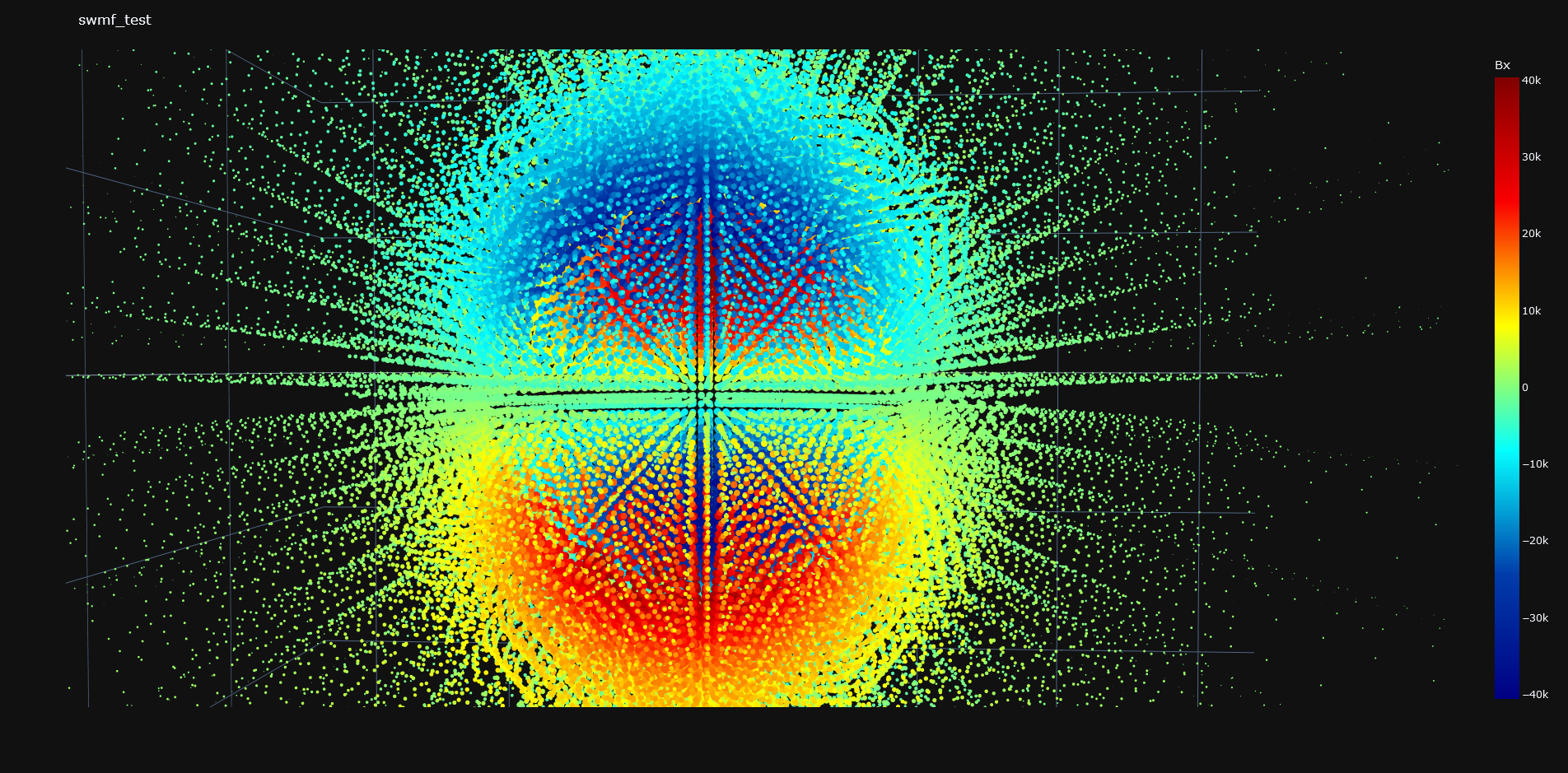
Geomagnetic 3D data from the SWMF So after releasing the last blog post, I would’ve never guessed, where my project would lead me. You can be sure, that I love this path, though. My plan for the next one is a bit vague. Since in the meantime some people of the real life told me “I have no idea, what you are doing there”, I’d like to give some insight about how using this model actually looks. But we will see about the future.
Direct link to article and comments: https://nahual.eu/on-plans/
-
On Project Nahual
What the project is all about and what it will be
Solar wind barrages onto our atmosphere every second. It consists of charged particles, which get heavily influenced by the magnetic fields of earth and sun. The interaction between solar wind and the earthly magnetic field results in the wonderful phenomenon of polar lights. A well more hidden effect of the earthly magnetic field is its protection aspect. It deflects and redirects the charged solar wind particles, which otherwise might strip away our atmosphere. Once again we can thank our planet for the Home it provides to us.
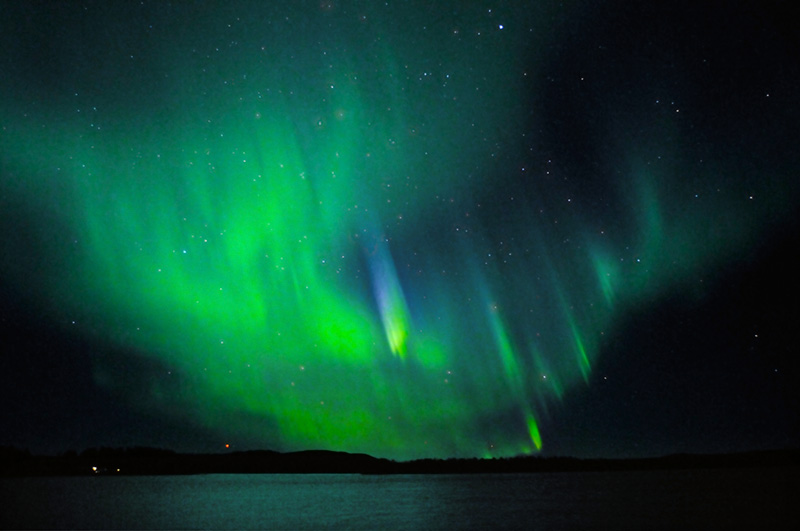
Northern lights by Varjisakka under creative commons licence When we look up to the sky, we find a planet which lived this fate. Our neighborly planet Mars is assumed to have a significant atmosphere a long time ago. It might have lost it due to many erosion effects, of which the drag of the solar wind is one of.
As I learned about the eroded and lost natural Mars atmosphere I was very sad, because it essentially makes any future terraforming efforts worthless. Without a magnetic field any artificial atmosphere on Mars would erode just like its natural one.
For a long time I thought terraforming Mars would be impossible and our closest neighbor cannot be a Home for us. One day in the far past of my life I heard from an idea, which stuck with me. James Green from NASA proposed at the NASA Planetary Science Vision 2050 Workshop the concept of a powerful magnet placed at the L1-Lagrange point between Sun and Mars. It would act as a shield for the Martian atmosphere. I was intrigued, kept the idea for a long time and began to search for more but did not find satisfying results.
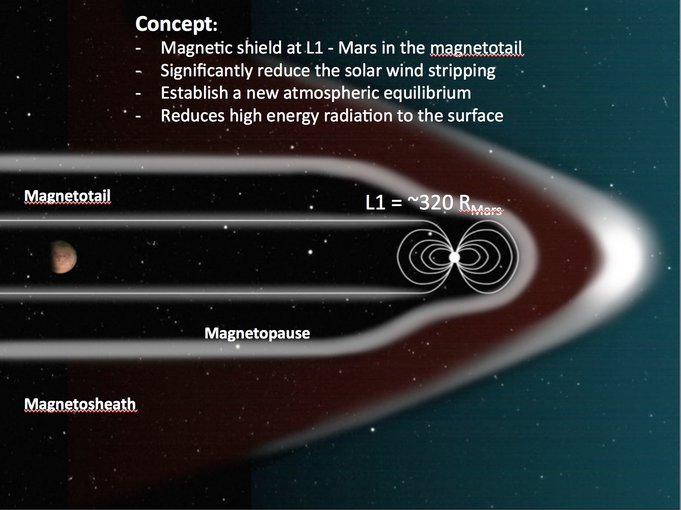
Magnet shield proposed by James Green from NASA at the NASA Planetary Science Vision 2050 Workshop – article link While there are proposals for this topic, as far as I know nobody actually analyzed the solar wind as source of the problem. Any designs orientate heavily at the structure of the earthly magnetic field. I want to deep dive into the plasma dynamics of the solar wind to maybe find a more efficient solution. The scope of Project Nahual is a comprehensive proposal for a Martian solar magnet shield.
For a first step I wanted to have an accurate description about solar wind. The most promising dataset is the one given by the WSA-Enlil model from the NOAA. I created a visualizer, which goes beyond the basic 2D one provided. However like I mentioned in the last blog article I will probably need a dataset specific for this purpose as well as a deep understanding of the model itself to advance in this project.
Apart from technical problems like having a magnetic field, which might need the size of a planet, or modeling the solar wind accurately enough, a realization would require huge investments. Because of this a practical project scope is far out of reach for me. Nevertheless I want to add to our understanding of our solar system. In the spirit of the always welcoming space community I want to share my ideas and my progress, even if I possibly will not find a feasible or even doable solution.
Join me, ask me, discuss with me or just read. Our fascination for the stars shines bright and I am happy to be here.
All sources, articles and pictures to download: On Project Nahual.zip
Direct link to article and comments: https://nahual.eu/on-project-nahual/
